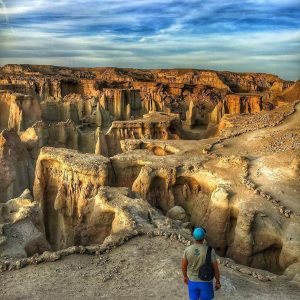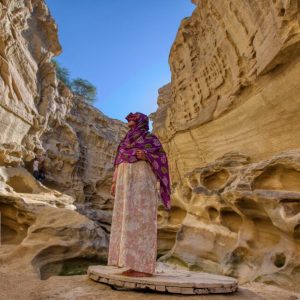Valley of the Stars is one of the unique geological phenomena on Qeshm’s Seven Wonders list and is more than two million years old. The Valley dazzles the eyes of every visitor who sees it. This Valley, which has few similar specimens globally, is one of the most mysterious and exciting attractions, including pointed cones, massive columns, and high walls. Each valley column has multiple layers and cavities that can easily penetrate air, formed by erosion caused by seasonal showers, surface waters, and hurricanes. These beauties make Valley of the Stars a UNESCO World Heritage Site. Interesting to know that Qeshm Geopark is the only one in the Middle East. The beauty of Qeshm Star Valley makes it one of the most popular places of interest in Hormozgan province, and many tourists visit it throughout the year.
Join this Iran Travel Guide Center article to learn more about Star Valley if you haven’t yet had the opportunity to travel to Qeshm.
Qeshm Valley of the Stars; A Natural Masterpiece

Star Valley is one of the most popular sites in Qeshm Geopark, which the locals call “Stale Kofteh” or “Setare oftadeh,” meaning “Fallen Star.” Residents of this region believe that the collision of a meteorite with the earth resulted in the soil and rocks thrown into the air, resulting in the formation of this Valley, hence its name, Fallen Star Valley.
The Valley of the Stars dates back roughly two million years to the Cenozoic geological period. Undoubtedly, a unique site like this results from the interaction of erosive factors such as water, wind, and weight pressure on different layers of the earth.
The impact of these factors has been less in the more durable sectors and has remained stable, while the weak and soft parts have been destroyed by erosion. The geometric shapes of Qeshm Star Valley are made of sand, stone, and calcareous cement.
The walls of this Valley are made of two completely different materials: a very thick and almost soft layer of cream to light grey below and a thin and complex layer of white to dark grey on top.
Erosion agents rapidly degrade the underlying loose layer; If the top layer is hard and acts as a shield for the bottom layer, it protects it from erosion. As a result of the destruction or cracking of the top layer, the decline has increased, and small valleys and cracks have formed.
The Valley of the Stars, according to indigenous beliefs:
The article mentioned one of the beliefs of the people of this region about the formation of the Valley of the Stars. Still, other opinions can be heard and are also interesting.

The sounds heard from the Valley of the Stars are attributed to ghosts upset by humans’ presence after sunset. This old belief is so serious for the people of this region that they will not enter the Valley after sunset. Would you believe in a spirit world?
Scientists have not confirmed this, and they believe that the cause of the sound is the wind blowing through the pillars and corridors of the Star Valley.
If you do not believe in the spirit world and are not afraid of these sounds, it is better to spend the night in this area to count the stars in the sky with your fingers and its fantastic tranquillity. The Valley of the Stars’ wonder begins just after sunset when you see a strange view of the galaxy.
Nighttime in Qeshm Star Valley
The night sky of this place will give you images in your mind that cannot be relived anywhere else. Because it is far from urban areas, the night sky in the Valley of the Stars is filled with stars.
In addition, if you have a professional camera, you can get good pictures of the moon and stars shining among the rocks or a beautiful sunrise. The stars are so close to you that you feel like you are in another world. This amazing view can be the best subject for photographers to capture stunning images.
When should you visit the Valley of the Stars?
The best season to visit the Valley of the Stars is autumn and winter, when the island’s climate is most favourable. In April and May, the weather on the island is temperate. However, the temperature on the island becomes very hot and exhausting from early June to late summer.
As well as visiting Qeshm Star Valley, make sure you also see the Namakdan Salt Dome, Portuguese Castle, Qeshm Geo Park, mangrove forests, Qeshm Roof, Statues Valley, Qeshm Mountain Strait, and Crocodile Park.

Hotels near Valley of the Stars
For accommodation and reservations of Qeshm hotels, you can choose between luxury hotels, boutique hotels, and economical hotels on the island, such as apartment hotels, according to your budget. In addition, if you want to learn more about the culture and customs of the native people of Qeshm, you can stay in Qeshm ecotourism resorts such as Khaneh Doost dehliz Ecotourism Resort, Chahkuh Ecotourism Resort, and Dehkhoda Ecotourism Resort.
On Qeshm Island, you can easily find all southern cuisine in local restaurants and enjoy its unique taste. If you like, most eco-lodges also serve traditional food on Qeshm Island.



No comment